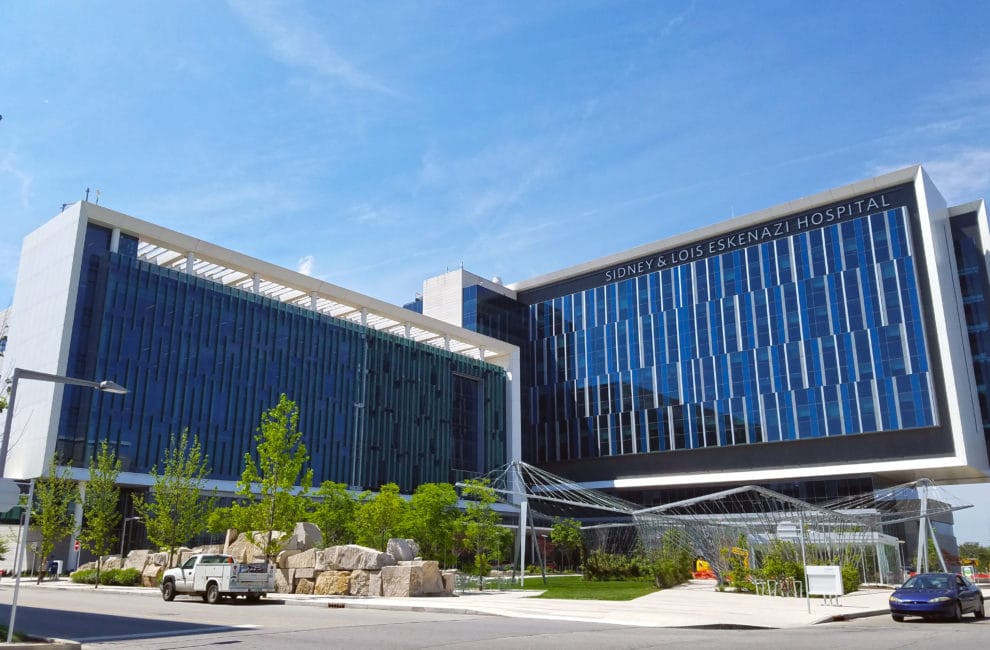Eskenazi Has A History With Epidemics

Sidney and Lois Eskenazi Hospital Courtesy Eskenazi Health
When Dr. Livingston Dunlap suggested building Indianapolis’s first hospital—what’s now the Sidney & Lois Eskenazi Hospital—amid a smallpox outbreak in 1847, the idea was roundly dismissed. The Indianapolis Journal called it “a moment of Democratic folly in the brain of Dr. Dunlap.”
Why do we need a sick house in a city of 6,500? people thought. Why can’t I recover at home?
It may seem strange that Hoosiers didn’t want a hospital amid a smallpox epidemic, especially at a time when hospitals across the country are facing critical shortages of beds and ventilators during the coronavirus crisis. But if you’re picturing a sparkling-clean facility filled with nurses and doctors in masks, gloves, and scrubs, think again.
Germ theory was still decades from becoming de rigueur in professional medicine, as was hand-washing. Isolation was the weapon of choice to staunch the spread of smallpox which, like the coronavirus, is transmitted through virus-packed droplets people expel when they cough or sneeze.
Although almshouses—places meant to house sick poor people—and pesthouses—meant to cordon off smallpox and cholera patients—had sprung up in larger Midwestern cities in the 1830s and 1840s, Hoosiers were skeptical of Dunlap’s idea of an institution that would care for—not just isolate—these individuals. Many feared “hospitalism” syndrome, or the belief that the putrid atmosphere of hospitals caused diseases.
In 1855, #EskenaziHealth was founded to help #Indy treat and manage a small pox pandemic. Now 165 years later,we still deliver quality health care and are helping #Indy manage the #COVID19 pandemic.#TBT pic.twitter.com/rQWAXdkWVf
— Eskenazi Health (@EskenaziHealth) April 9, 2020
But by 1854, when a smallpox outbreak menaced the city once again, the public—and, more importantly, the Indianapolis Common Council, which held the purse strings—had come around. The council green-lit the construction of a public hospital “to receive the stranger, the unfortunate, and the destitute”—on the taxpayer’s dime, according to Hester Anne Hale in her 1999 book Caring for the Community: The History of Wishard Hospital.
The site of choice was a swampy patch in the city’s far northwest corner, at what’s today the intersection of 10th Street and Indiana Avenue. Construction began in 1855.
But hospitals don’t just spring up overnight, and by the time the building was completed in 1859, the smallpox outbreak was over. For the next couple of years, prostitutes and homeless people cohabited with insect swarms, livestock flattened the fence gates, and raindrops spattered the floor through a leaky roof. Any public support that had existed had vanished.
The Common Council tried unsuccessfully to give “Dunlap’s Folly” away, but the building was in such bad shape that even the Sisters of Charity declined. But the city found a grateful recipient after the 1861 outbreak of the Civil War: the federal government, which turned it into a military hospital that treated an estimated 13,000 sick and wounded soldiers until 1865.
After the war ended in 1866, the council established the Indianapolis City Hospital as a permanent 75-bed facility that served both paying and charity patients. A few name changes—Indianapolis General Hospital, Wishard Memorial Hospital, and now Sidney & Lois Eskenazi Hospital—later, the former fixer-upper grew into a public health care network that serves nearly one million outpatient visitors each year at its campuses around the city (it moved a half mile west to its current $754 million modern digs along the White River in 2013).
And now, amid the coronavirus crisis, the hospital once popularly known as “Dunlap’s Folly” is again stepping up in response to an outbreak — though this time, with the public’s support.





